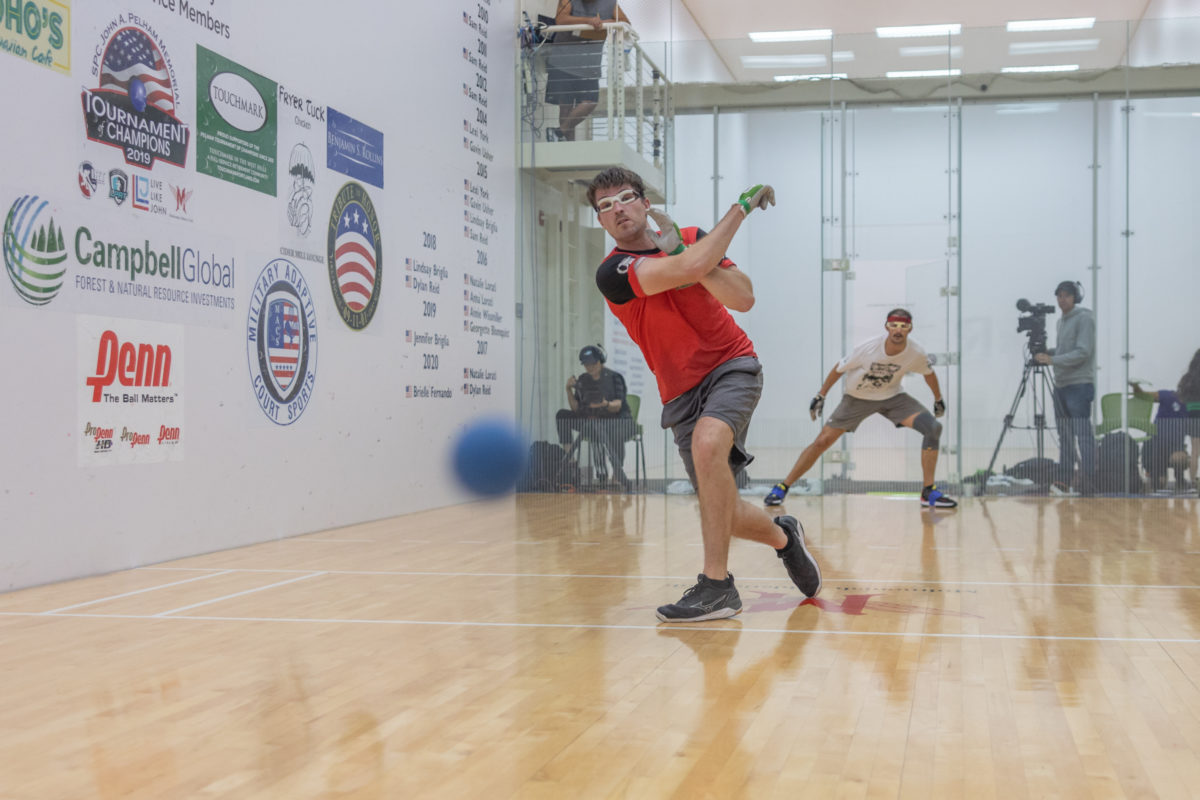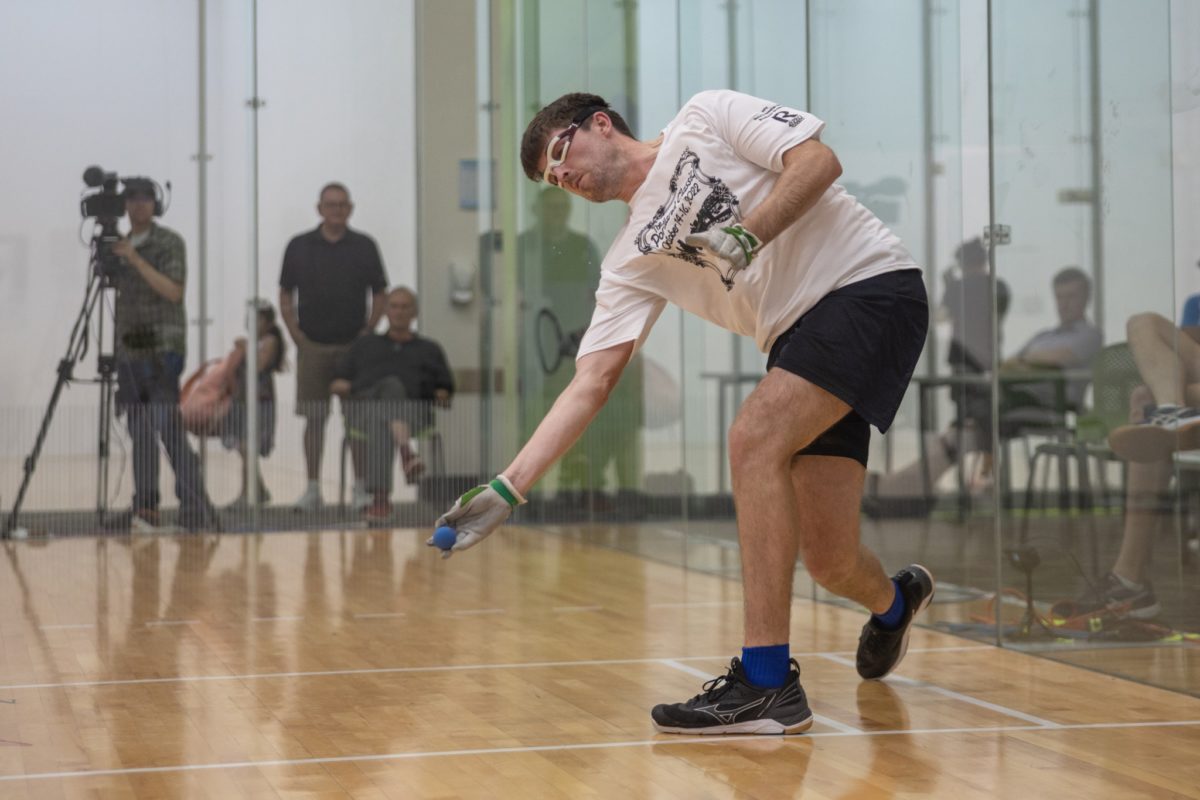T.O.’s Corner: Helping Handballers Become Fitter and Recover More Quickly
WPH Press, Tucson, AZ
By Travis Owen, MS, CSCS, PN1
Nothing is more satisfying to any handball enthusiast than seeing a great shot as the result of a smooth, powerful, rotational swing. This crisp shot where all of the swing seems to get transferred efficiently into the ball, has certain key rotational components that we’ll discuss below.
The WPH center was able to send me some footage of Martin Mulkerrins’ swing, one of the hardest hitters currently in the game, and I love how some of these clips demonstrate extremely efficient rotation. First, click HERE and watch at the :20 second mark (the front view) during Martin’s serve. Now this is not only done on the serve- it happens on many other shots, and it’s certainly not just unique to Martin. But notice how during the swing, his back foot turns so much that his shoelaces are facing the target. This ensures there is no weight on the back foot while rotating. While yes, the push off does happen from the back foot, once the hips start to rotate his momentum is fully blocked by a stable front leg allowing his back foot to be “freed up” to move forward and rotate fully.
One of the biggest mistakes when it comes to rotation is “drifting” forward during the swing- so that the front leg isn’t stable, and the body drifts forward too much during the swing. Now of course, there are plenty of different shots in handball, so it’s not as if it’s bad to “drift” during a swing, but to achieve top power and hip rotation, a stable front leg and full hip rotation is what you’ll see in the hard hitters. Just simply watch Killian Carrol and Paul Brady warming up HERE and you’ll see the exact same thing.
So now that we’ve established the what, let’s look at more importantly, the how.
First and foremost is the ability to rotate the hips while avoiding early shoulder rotation. This is called hip-shoulder separation. If, for example, our hips rotate, but we don’t have the mobility to keep the shoulders from rotating too early, there will not be nearly the maximum amount of power developed. It is also common in these scenarios to “pull off” the ball too much. Even if you get a lot of power by rotating the hips, it’s difficult to stay on the ball and, for example, hit it hard down the side wall from the center of the court.
These two articles, HERE and HERE, cover mobility- in particular T-Spine mobility, and drills you can do to improve or maintain your mobility. Additionally, This mobility exercise is one of my favorites for maintaining T-Spine mobility and hip-shoulder separation.
Next, and relatedly, it’s incredibly important when it comes to maximizing the power developed from that hip-shoulder separation to have a strong functional core. No, this doesn’t mean just crunching away at kyphotic-posture-inducing sit-ups, but rather long-spine, posture enhancing core exercises that help the core stay long and additionally works the deep core musculature. I have rarely been a fan of sit-ups and crunches for athletic performance, since it cranks on the spine and works primarily the superficial muscles of the core (i.e. rectus abdominis), plus promotes a hunched-over posture which we want to avoid since handball involves a lot of leaning over anyway, and scapular health is so important in our sport.
Functional core exercises like side planks, front planks, and variations of these exercises are keeping the core from rotating, and controlling the pelvis and spine. This is basically like making a rubber band “thicker,” so that when you have the hip-shoulder mobility to stretch that rubber band out, it will snap back to neutral with even more power.
Besides the functional core exercises mentioned above, one of my favorites for rotational athletes is the pallof press (see HERE). Use a band or pulley to provide tension that pulls to the side, so that your core must remain strong and stable in a neutral position, and in good posture.
Finally, while these two aspects (sufficient hip & T-Spine mobility, and core stability) are a very important foundation, power can then be training through strength and plyometrics that challenge certain movements. This topic could be an entirely new post, but some of my favorite rotational plyometrics involve med balls and hip extension exercises (e.g. rotational throws, or overhead throws/slams), and of course there’s no question that some of the best strengthening exercises- particularly for the hips & legs which of course are the foundation of a powerful rotational athlete, are exercises like deadlifts, RDLs, or other hip-hinging exercises.
We often hear about the importance of strength and mobility when it comes to achieving athletic movements, so hopefully this post was able to shed light on what’s necessary and the “why” for handball players.
Travis Owen is the founder of his training service Travis Owen Performance (T.O. Performance) and has been involved with handball since picking it up in college in 2005. CSCS Certified through the National Strength & Conditioning Association and having earned his Master’s degree in 2011, Travis has been training individuals of all types for over 10 years. With an initial focus on softball & baseball athletes, Travis is starting to expand his reach to handball players and would like to elevate the game by providing articles and videos, as well as program design or training for anyone interested.
Contact Travis by email at owenperformanceTO@gmail.com, or travisowenperformance.com











